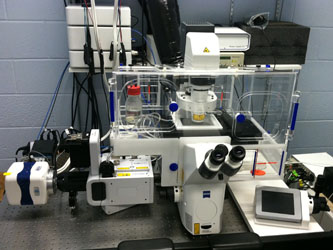
Unlike the confocal laser-scanning microscope, which takes several seconds to generate a single image (and several minutes to generate a high contrast, high resolution series of images), a spinning disc confocal microscope collects an image in a fraction of a second (and a series of images in a few seconds). This is due to the fact that the emitted light passing back through the Nipkow disc covers the entire detection field of the CCD camera once the disc has rotated approximately 30°. Given the high speed of the disc rotation (approximately 1800 rpm) and the high efficiency of the CCD camera, images may be collected in time frames of milliseconds. As a result of the increased speed of image acquisition, there is the obvious increase in temporal resolution when imaging dynamic events in living cells, viable tissue preparations and organisms. Furthermore, given the increased efficiency of the Yokogawa spinning disc system and the increased efficiency of emCCD cameras, lower intensities of illumination may be used, which provides for a reduced phototoxicity in samples exposed to short wavelength light and less photobleaching of the fluorescent labels.
The facility houses a Zeiss Cell Observer Spinning Disc confocal microscope configured around a fully automated and programmable AxioObserver Z1 inverted stand and equipped with a Yokogawa CSU-X1A spinning disc unit, 2 Photometrics Evolve 512 cooled emCCD cameras (for high speed, high sensitivity imaging), an Axiocam MRm (for widefield imaging), a high resolution piezo driven Z stage (for rapid 3D data collection) and motorized XY stage that permits multi-point time-lapse imaging. Illumination sources include lasers (405 nm, multi-line Ar [458/488/514 nm], 561 nm, 635 nm), LED (485, 555 nm) and metal halide. Objective lenses include 10x, 20x, 40x oil immersion, 63x oil immersion, 63x water immersion, 100x oil immersion. The microscope also includes a full stage incubation system that regulates temperature, CO2, O2, and humidity.
